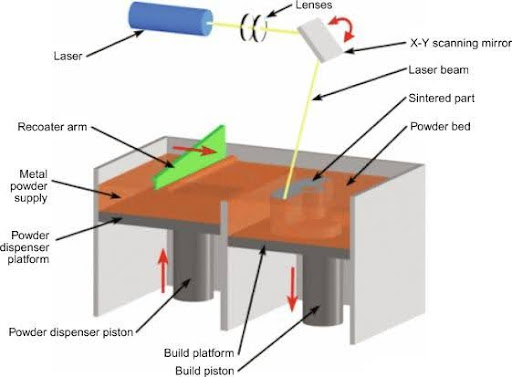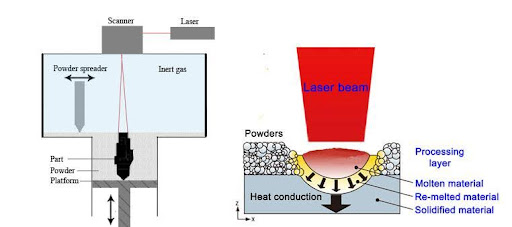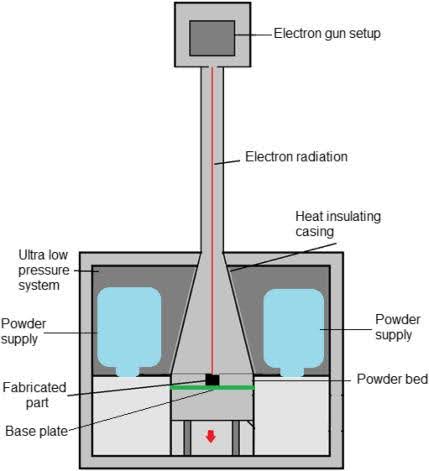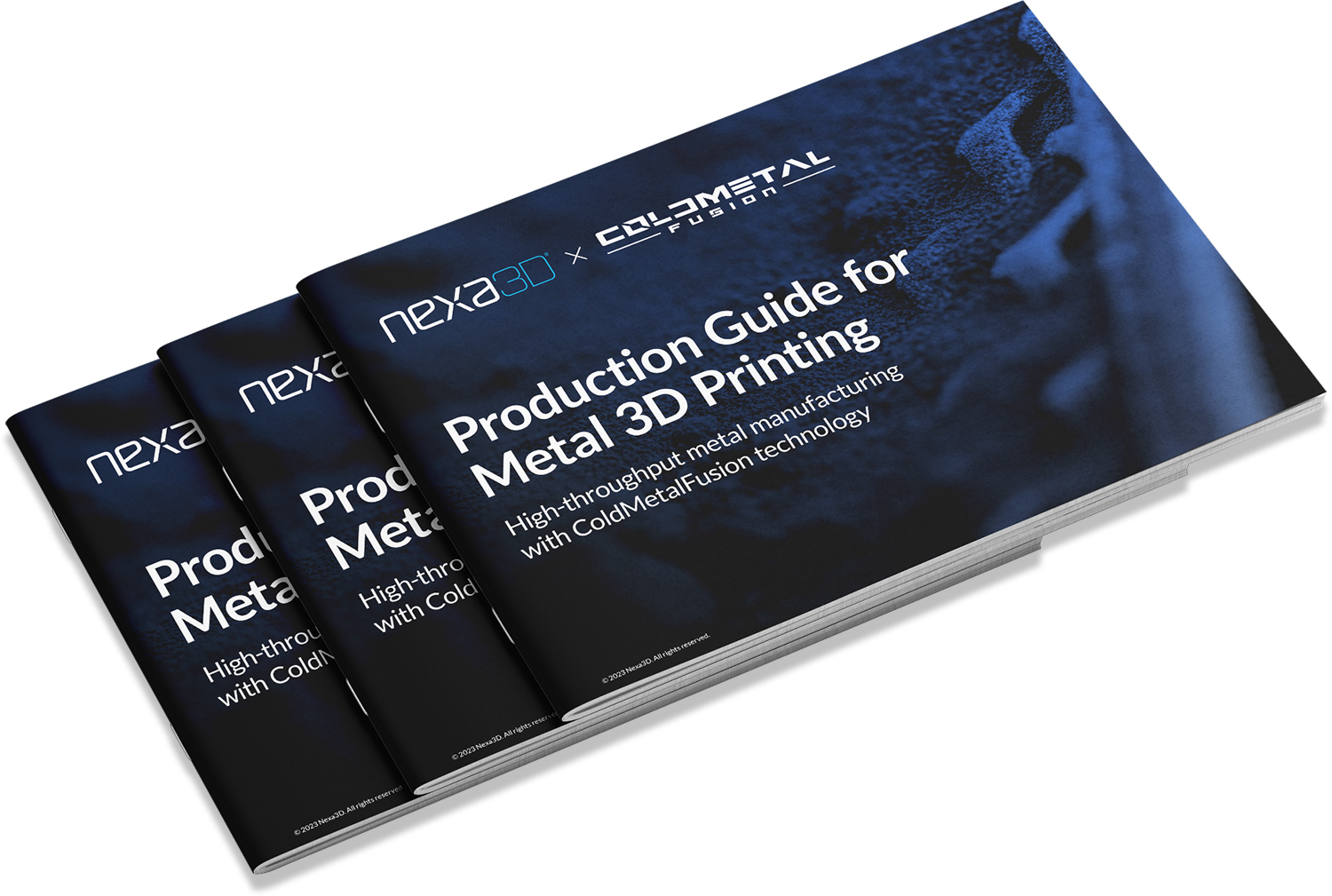- Markforged Onyx Filament Review & Alternatives [2024] - December 11, 2024
- 17 Best Professional 3D Printers: Commercial, Desktop, & Industrial [2024] - December 10, 2024
- Best 3D Printers (Industrial, Desktop, & More) [2024 Guide] - July 20, 2024
Metal 3D printing combines the versatility of metal materials with the advanced capabilities of 3D printing. This process enables the creation of intricate, precise, and durable components. It’s a game-changer, particularly for sectors like aerospace, healthcare, and automobiles, which require custom solutions that can withstand extreme conditions.
In this guide, we’ll explore everything you need to know about metal 3D printing, what it is, how it works., and the best metal 3D printing materials to work with.
What is Metal 3D Printing?
Metal 3D printing works by fusing metal particles using high temperatures derived from lasers or electron beams. The process creates metal objects by sintering, melting, or welding layers of metal or metal powder until a part is complete.
Another form of metal 3D printing uses a binder or polymer to bond metal particles together and form a green part. Those parts then go through a debinding process to remove excess binder and then into a sintering process to fuse those metal particles into the final metal part.
Materials such as stainless steel, aluminum, and titanium are commonly selected in metal 3D printing to craft both prototype models and functional end-use items.
What is Metal 3D Printing Used For?
Some key use cases of metal 3D printing include:
- Aerospace: Metal 3D printing is instrumental in the custom production of lightweight, high-strength components such as engine parts, injectors, and brackets. This goes a long way in improving the structural integrity of aircraft.
- Automotive: Similarly, metal 3D printing is used to create custom parts, prototypes, and intricate components that improve the performance of vehicles.
- Healthcare: Metal 3D printing goes a long way in creating patient-specific prosthetics, custom implants, and other tailored solutions.
- Energy and Electronics: The energy and electronic industries use metal 3D printing to create custom components like turbine blades, heat exchangers, heatsinks, and connectors.
Metal 3D Printing Techniques
Metal 3D printing comes in various types and techniques. The most popular metal 3D printing techniques to date include the following:
ColdMetalFusion

ColdMetalFusion (CMF) combines high-throughput laser sintering with established powder metallurgy processes to deliver metal components with exceptional performance, repeatability, and precision.
ColdMetalFusion is similar to metal injection molding, but it is equipped with design freedom and fast production typically associated with 3D printing. ColdMetalFusion utilizes the patented metal powder feedstock from Headmade® Materials. This feedstock has a thin polymer coating over each metal particle used to bond particles together during the sintering process. Each particle is sintered at a low temperature in Nexa3D’s fast-cycle QLS printers. Following the printing phase, components undergo a certified debinding and sintering procedure that eliminates the polymer through a burnout process, resulting in fully metal parts.
Pros:
- Wide material spectrum as it works with a range of metals like aluminum and titanium
- Eliminate time-consuming and costly post-processing like support removal, heat treatment, and stress relief
- High-resolution printing with lower production costs up to 90%
- Sustainable and eco-friendly with the right printers
- Enables you to print freely, uninhibited by the constraints of traditional manufacturing or the limitations of direct metal laser melting processes
- Adopted across various industries such as aerospace, automobile, and healthcare
- Enables the creation of intricate metal parts with complex geometries
- Low-to-no material waste
- Scalable for production applications
Cons:
- Not suited for 3D printing hobbyists
When to use ColdMetalFusion: Production of intricate, high-quality metal parts without the complexity and waste of traditional manufacturing.
Discover the future of making metal parts with Nexa3D’s QLS Series SLS printers, designed for ColdMetalFusion. Experience ultra-fast printing and the flexibility to use various materials.

DMLS®

Direct Metal Laser Sintering (DMLS) involves the full melting of metal rather than just sintering. This technique can yield up to 95% dense steel parts with good resolution and thin layers. It uses a variety of metals such as aluminum, bronze, cobalt-chrome, titanium, alloy steel, stainless steel, and tool steel.
Having entered commercial use in 1995, DMLS is a relatively recent addition to the 3D printing landscape.
Pros:
- A diverse selection of metal materials
- Incorporates Direct Metal Printing (DMP) techniques
- Creates highly durable and exceptionally strong parts
- Eliminates the need for support structures, enhancing dimensional and design integrity
- Ability to reuse unsintered metal after production
Cons:
- Slower print speeds in comparison to other 3D printing methods
- High ownership, operating, and processing costs
- Limited build volume
- Inferior surface finish compared to ColdMetalFusion
- Requires support structures
- Difficult to scale for higher-volume production
When to use DMLS: Producing unique shapes and designs with stable mechanical and material properties
SLM

Selective Laser Melting (SLM) is a metal 3D printing method that employs a high-powered laser beam to fuse metal particles together. Unlike Selective Laser Sintering (SLS), which sinters powder particles, SLM’s complete melting results in structures that boast enhanced strength and reduced porosity.
SLM is used for fabricating parts from aluminum alloys, titanium and its alloys, stainless steel, and more exotic metals like tungsten.
Pros:
- Produces exceptionally strong metal parts
- Yields highly precise and intricately detailed creations
- Parts can withstand a high mechanical load
- Provides a diverse selection of metal materials
Cons:
- Requires a supply of inert gas to prevent oxidation during production
- SLM systems are typically costly to install and own
- Metal parts require extensive post-processing to achieve desired surface finish
- Requires the use of supports and overhangs
- Required support structures cause increased material usage.
When to use SLM: Manufacturing dense, complex parts from aluminum alloys, titanium and its alloys, stainless steel, and more exotic metals like tungsten.
EBM

Electron beam melting (EMB) is a powder bed fusion technology that involves using a high-energy beam of electrons to melt powdered metal particles and fuse them together to create a 3D structure. The beam produces a strong stream of electrons guided by a magnetic field, melting metal powder in a path predetermined by a CAD file. The entire melting process occurs within a vacuum chamber, eliminating the risk of oxidation or for reactive materials.
Pros:
- Lower initial and setup costs compared to other Powder Bed Fusion (PBF) methods
- Reduced risk of oxidation with the vacuum environment
- Greater design freedom for complex structures
Cons:
- Limited material variability
- Lower-quality surface finish that is similar to sand casting
- Requires extensive post-processing
When to use EBM: To print components for aerospace, automotive, defense, petrochemical, and medical applications.
How Does Metal 3D Printing Work?
Metal 3D printing, like any other additive manufacturing process, operates on the principles of additive layering to construct objects layer by layer directly from metal materials.
Metal 3D Printing Materials
The core 3D printing materials used are finely powdered metals, which can include stainless steel for its robustness and versatility, aluminum for a favorable strength-to-weight ratio, titanium known for its strength and biocompatibility, and various nickel alloys that are resistant to high temperatures and corrosion.
Additionally, precious metals like gold and silver are used for custom jewelry and intricate electronic components. Each material is chosen based on the specific properties required for the final component, such as durability, corrosion resistance, or aesthetic appeal, and is meticulously transformed from a digital model into a solid, three-dimensional object with precise structural integrity and functionality.
Metal 3D Printing Software
Every 3D printing process begins with creating a computer-aided design (CAD) file of the structure to be printed. CAD software is a specialized digital software that is used to design and model the blueprint of the object to be printed in the form of a CAD file. The file helps in the creation, manipulation, analysis, or optimization of a design while also acting as a map for the metal 3D printing process.
The file is saved in a format that a 3D printer understands, usually STL or G-code and it is then uploaded to the 3D printer, which in turn interprets and utilizes the file in the printing process. This file governs the printing process, offering information such as layer size, shape, and sintering sequence to ensure the metal is printed to detail.
Metal 3D Printing Post-processing
Post-processing in metal 3D printing refers to the actions taken after the initial printing phase is completed to improve the quality, performance, and appearance of the manufactured parts. These steps are crucial as they enhance the material properties and dimensional accuracy of the printed items.
Post-processing methods include the removal of support structures, which are often necessary during printing to uphold complex geometries, and surface finishing techniques, such as sandblasting or polishing, to achieve the desired surface smoothness. Thermal treatments like stress relief annealing and hot isostatic pressing are also commonly used to enhance the mechanical properties and to relieve residual stresses.
Precision machining may be employed to refine dimensional tolerances and achieve the precise final dimensions required for technical applications. The choice of post-processing techniques depends greatly on the intended use of the part, the material used, and the standards of the specific industry it will serve.
Metal 3D Printing Costs
The cost of metal 3D printing is the financial investment required to produce parts, often reflecting the price of the raw materials, the type of metal printing system used, the volume of the parts, and the degree of post-processing needed.
Metal powders such as titanium, stainless steel, and specialty alloys are premium materials with pricing that can significantly influence the overall cost. The machinery itself, which ranges from CMF, SLM, and DMLS to EBM, represents a substantial capital expense with ongoing operational costs, including energy consumption and maintenance.
Furthermore, the complexity of the design and the density of the metal parts can extend print times and resource use, thus elevating the cost.
Additionally, post-printing processes, which may involve cutting, heat treatment, and surface finishing, add to the expense.
Metal 3D Printing Services
Metal 3D printing services provide on-demand access to advanced metal additive manufacturing technologies for businesses and individuals without requiring a direct investment in costly printing equipment and specialized staff. These external services enable clients to manufacture complex metal parts and prototypes with various materials and processes, along with offering professional guidance in design optimization and post-processing treatments for the final products.
However, for organizations that consistently need to produce large volumes of parts or highly confidential prototypes, investing in in-house metal 3D printing capabilities might be more beneficial. Owning the equipment allows for greater control over the production process, protects intellectual property, reduces lead times by eliminating reliance on third-party service schedules, and may ultimately be more cost-effective at scale.
Additionally, having a dedicated setup can foster innovation and rapid prototyping, which can be critical in fields such as aerospace, automotive, and medical device manufacturing where customization and speed are essential.
Use the Best Metal 3D Printing Process
When it comes to metal 3D printing, you’re faced with lots of options, each with its own set of capabilities and advantages. However, if you need a technology that stands out in terms of efficiency, quality, and scalability, ColdMetalFusion should be at the top of your list.
Here’s why CMF is the smart choice for your metal 3D printing needs:
- Unmatched Design Freedom: CMF allows for complex, precision designs unachievable by traditional manufacturing.
- Consistent Quality: Uniform processing leads to repeatable, high-quality results every time.
- Streamlined Production: Less need for post-processing saves time and streamlines your operation from start to finish.
- Cost Savings: Reusable materials and no need for support structures mean lower costs.
- Speed to Market: Rapid printing technology gets your product from concept to reality faster.
- Sustainability: A reduction in waste makes CMF an environmentally responsible choice.
For those looking to push the boundaries of what’s possible in metal fabrication, adopting ColdMetalFusion combined with Nexa3D SLS 3D printers is the way forward.
Ready to experience it yourself?
Learn more about ColdMetalFusion with Nexa3D


